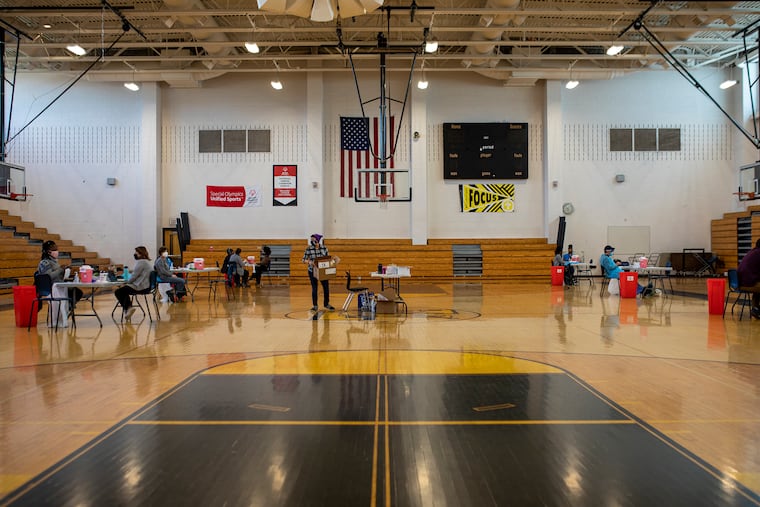Philly leaders lied for decades about school safety. Why should teachers trust them during a pandemic? | Opinion
The district still lacks a robust testing strategy and has failed to provide ventilation reports for many schools expected to return.

Last November, when the Philadelphia School District aimed to reopen in-person schooling, the plan was thwarted by a surge in coronavirus cases. So now that the district is again attempting to reopen schools, the number of cases has declined, right? Wrong.
In November, Thomas Farley, the head of the Philadelphia Department of Public Health, reported an average of 387 new cases per day, enough to cancel school reopening. But in his most recent update, Farley explains that for the past week, we averaged 401 cases per day and 518 the previous week.
» READ MORE: As schools seek to reopen, here’s what local data say about in-person classes and COVID-19
While this seems to be part of a downward trajectory, our community transmission rate reached “substantial” according to state guidelines the week of Oct. 18 and has remained there ever since. The first cases of the more contagious coronavirus variants are being reported near Philadelphia; without a quicker vaccine rollout, these variants will likely cut short some of the progress that has been made.
So why is now the time to reopen in-person schools?
One of the reasons school districts across the country are attempting to reopen is a new article published by three CDC scientists that claims there is little evidence that schools have contributed to the spread of COVID-19. Leaving aside that the U.S. studies cited in the article were conducted in rural or suburban school districts, and took place before the new variants reached our shores, the authors make clear that preventing outbreaks in schools requires mandatory masks, frequent and rapid testing, low class sizes to maintain social distancing, increasing room air ventilation, and, most importantly, “addressing and reducing levels of transmission in the surrounding communities through policies to interrupt transmission (e.g., restrictions on indoor dining at restaurants).”
Not only is Philadelphia moving in the opposite direction, having just eased restrictions mid-January allowing indoor dining, but as the Philadelphia Federation of Teachers has made clear, the district has not developed a robust testing strategy and has failed to provide ventilation reports for many schools expected to return.
Another reason offered by Superintendent William R. Hite Jr. is “the lack of in-person learning disproportionately harms low-income and minority children” and “this means our most vulnerable children are falling further behind.” But the students who have signed up for in-person learning tend to be wealthier and whiter, Chalkbeat Philadelphia reported. No doubt the devastation COVID-19 has wrought on Black communities in Philadelphia will make many wary about sending students back to school buildings. But those who remain virtual will struggle more as their teacher, now masked and distanced, will attempt to simultaneously teach the students in front of them and those tuning in from home.
» READ MORE: Some Philly kids can finally return to school next month after nearly a year away. Reactions are mixed.
For all the discussion of children learning best in person, there is little acknowledgment that masked, socially distanced learning is markedly different from the relationship-rich learning that makes face-to-face instruction better.
For young children, the pre-pandemic classroom emphasized the importance of sharing and interacting with friends. By contrast, a pandemic classroom would be centered around pandemic rules. They cannot share items like toys, markers, or crayons. Another big emphasis of the pre-pandemic classroom was learning about feelings and emotions. This has continued virtually. In the pandemic classroom, however, those feelings would be literally masked. No longer can students and teachers read a smile or a frown. English-language learners would be at a particular disadvantage, as the ability to see mouths moving during speech is critical to language development.
For older kids still remote, the quality of virtual instruction is directly tied to the district’s investment in their hybrid plan. Part of the reason high school schedules cause stress for so many students is that they haven’t been reimagined to fit virtual learning. Higher-quality remote education is sacrificed for the fantasy of a speedy reopening.
» READ MORE: Philly school board silences teachers, parents, and students with new meeting structure | Opinion
Coinciding in time with the push to reopen schools, the school board — which continues to meet virtually — has implemented new rules cutting speaking time and limiting speakers at board meetings. They may not want a repeat of September, when public outcry forced them to postpone the reopening plan. Combined with Philly’s chief education officer’s recent defense of an unelected school board, this reveals a disturbing skepticism about democracy amongst our school leaders.
District leaders ask us to trust them to keep teachers, students, and our families safe. But these same leaders have kept us in poisoned schools for decades, with unsafe building conditions of lead, mold, and asbestos. The district needs to build trust by engaging in a democratic process to ensure teachers and our union that our buildings are safe enough to reopen. Without this, they will provoke an unnecessary confrontation.
A city that blundered vaccine distribution by trusting a group of white college kids whose previous experience was making memes on Twitter and producing parkour videos, while sidelining the Black Doctors Consortium, is in no position to ask unvaccinated teachers to trust city officials who claim schools are safe to reopen. Teachers desperately want to return to in-person classes, but there is not enough evidence that it is safe to do so.
Adam Sanchez teaches African American history at Lincoln High School in Philadelphia and is an editor of Rethinking Schools. Nina Willbach is a pre-K teacher and building committee member at Southwark Elementary School in South Philadelphia.